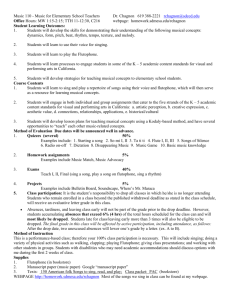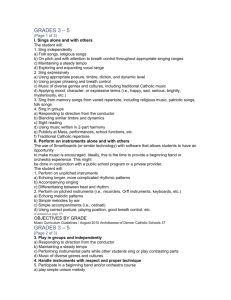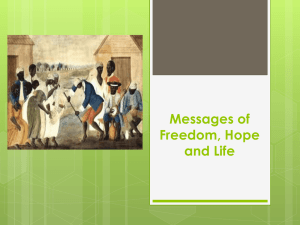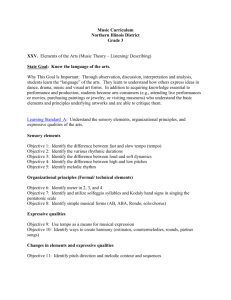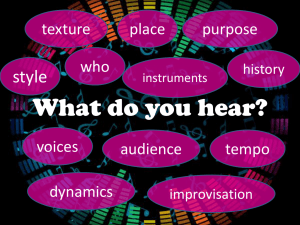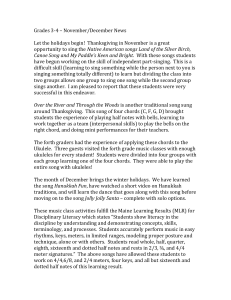New Curriculum Music
advertisement
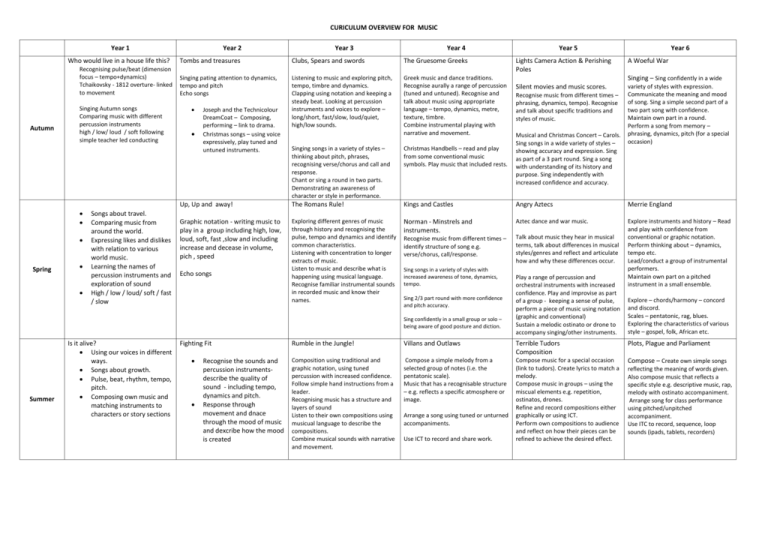
CURICULUM OVERVIEW FOR MUSIC Year 1 Who would live in a house life this? Recognising pulse/beat (dimension focus – tempo+dynamics) Tchaikovsky - 1812 overture- linked to movement Autumn Singing Autumn songs Comparing music with different percussion instruments high / low/ loud / soft following simple teacher led conducting Spring Songs about travel. Comparing music from around the world. Expressing likes and dislikes with relation to various world music. Learning the names of percussion instruments and exploration of sound High / low / loud/ soft / fast / slow Year 2 Year 3 Year 4 Tombs and treasures Clubs, Spears and swords The Gruesome Greeks Singing pating attention to dynamics, tempo and pitch Echo songs Listening to music and exploring pitch, tempo, timbre and dynamics. Clapping using notation and keeping a steady beat. Looking at percussion instruments and voices to explore – long/short, fast/slow, loud/quiet, high/low sounds. Greek music and dance traditions. Recognise aurally a range of percussion (tuned and untuned). Recognise and talk about music using appropriate language – tempo, dynamics, metre, texture, timbre. Combine instrumental playing with narrative and movement. Joseph and the Technicolour DreamCoat – Composing, performing – link to drama. Christmas songs – using voice expressively, play tuned and untuned instruments. Summer Lights Camera Action & Perishing Poles Year 6 A Woeful War Singing – Sing confidently in a wide Silent movies and music scores. Recognise music from different times – phrasing, dynamics, tempo). Recognise and talk about specific traditions and styles of music. variety of styles with expression. Communicate the meaning and mood of song. Sing a simple second part of a two part song with confidence. Maintain own part in a round. Perform a song from memory – phrasing, dynamics, pitch (for a special occasion) Singing songs in a variety of styles – thinking about pitch, phrases, recognising verse/chorus and call and response. Chant or sing a round in two parts. Demonstrating an awareness of character or style in performance. Christmas Handbells – read and play from some conventional music symbols. Play music that included rests. Musical and Christmas Concert – Carols. Sing songs in a wide variety of styles – showing accuracy and expression. Sing as part of a 3 part round. Sing a song with understanding of its history and purpose. Sing independently with increased confidence and accuracy. Up, Up and away! The Romans Rule! Kings and Castles Angry Aztecs Merrie England Graphic notation - writing music to play in a group including high, low, loud, soft, fast ,slow and including increase and decease in volume, pich , speed Exploring different genres of music through history and recognising the pulse, tempo and dynamics and identify common characteristics. Listening with concentration to longer extracts of music. Listen to music and describe what is happening using musical language. Recognise familiar instrumental sounds in recorded music and know their names. Norman - Minstrels and instruments. Aztec dance and war music. Explore instruments and history – Read and play with confidence from conventional or graphic notation. Perform thinking about – dynamics, tempo etc. Lead/conduct a group of instrumental performers. Maintain own part on a pitched instrument in a small ensemble. Echo songs Recognise music from different times – identify structure of song e.g. verse/chorus, call/response. Sing songs in a variety of styles with increased awareness of tone, dynamics, tempo. Sing 2/3 part round with more confidence and pitch accuracy. Sing confidently in a small group or solo – being aware of good posture and diction. Is it alive? Using our voices in different ways. Songs about growth. Pulse, beat, rhythm, tempo, pitch. Composing own music and matching instruments to characters or story sections Year 5 Fighting Fit Recognise the sounds and percussion instrumentsdescribe the quality of sound - including tempo, dynamics and pitch. Response through movement and dnace through the mood of music and dexcribe how the mood is created Talk about music they hear in musical terms, talk about differences in musical styles/genres and reflect and articulate how and why these differences occur. Play a range of percussion and orchestral instruments with increased confidence. Play and improvise as part of a group - keeping a sense of pulse, perform a piece of music using notation (graphic and conventional) Sustain a melodic ostinato or drone to accompany singing/other instruments. Explore – chords/harmony – concord and discord. Scales – pentatonic, rag, blues. Exploring the characteristics of various style – gospel, folk, African etc. Rumble in the Jungle! Villans and Outlaws Terrible Tudors Composition Plots, Plague and Parliament Composition using traditional and graphic notation, using tuned percussion with increased confidence. Follow simple hand instructions from a leader. Recognising music has a structure and layers of sound Listen to their own compositions using musicual language to describe the compositions. Combine musical sounds with narrative and movement. Compose a simple melody from a selected group of notes (i.e. the pentatonic scale). Music that has a recognisable structure – e.g. reflects a specific atmosphere or image. Compose music for a special occasion (link to tudors). Create lyrics to match a melody. Compose music in groups – using the miscual elements e.g. repetition, ostinatos, drones. Refine and record compositions either graphically or using ICT. Perform own compositions to audience and reflect on how their pieces can be refined to achieve the desired effect. Compose – Create own simple songs Arrange a song using tuned or unturned accompaniments. Use ICT to record and share work. reflecting the meaning of words given. Also compose music that reflects a specific style e.g. descriptive music, rap, melody with ostinato accompaniment. Arrange song for class performance using pitched/unpitched accompaniment. Use ITC to record, sequence, loop sounds (ipads, tablets, recorders)
